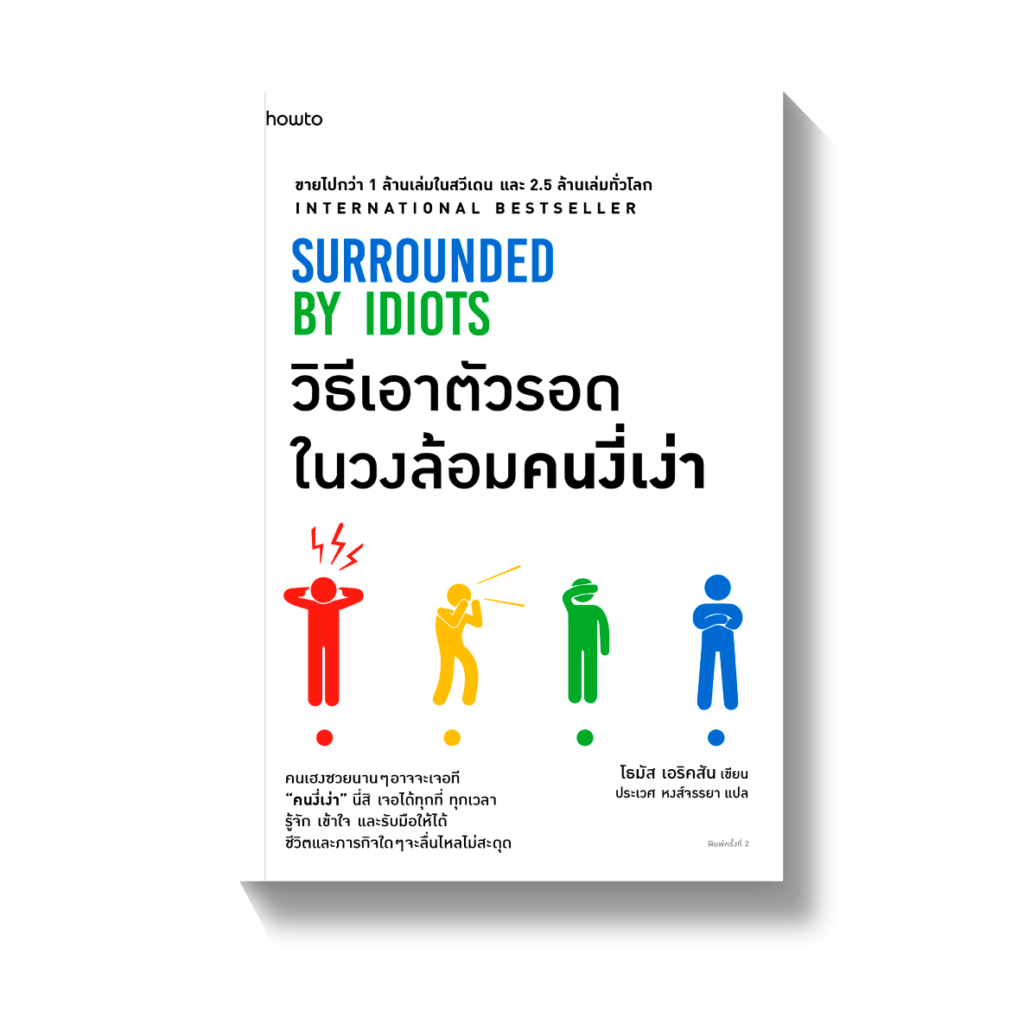
Surrounded By Idiots หรือ หนังสือแปลไทย “วิธีเอาตัวรอดในวงล้อมคนงี่เง่า” เป็นหนังสือจิตวิทยาที่น่าสนใจเล่มนึง ที่สามารถช่วยให้ผู้อ่านอย่างพวกเรา มีความเข้าใจ มีวิธีการในการใช้ชีวิตท่ามกลางคนงี่เง่าได้
หนังสือเล่มนี้ เขียนโดย Thomas Erikson โดยในหนังสือเล่มนี้ ผู้เขียนได้แบ่งบุคคลออกเป็น 4 สีที่แตกต่างกัน ได้แก่ สีแดง สีเหลือง สีเขียว และสีน้ำเงิน ทำให้เราเข้าใจบุคลิกภาพของตนเองและเข้าใจคนอื่นๆ แต่ละแบบมากขึ้น นอกจากนี้ผู้เขียนยังส่งเสริมและสนับสนุนให้คนรู้จักความเห็นอกเห็นใจ รู้จักชื่นชมความแตกต่าง ซึ่งผลที่ตามมา เราก็จะสามารถปรับตัวและเลือกวิธีการการสื่อสารที่มีประสิทธิภาพกับคนแต่ละแบบที่แตกต่างกันได้ หากเราเข้าใจกันและกันและเลือกวิธีการปฏิบัติต่อกันได้อย่างถูกต้อง ปัญหาเรื่องความสัมพันธ์ หรือ ความขัดแย้งก็จะเบาบางลงไปได้
“การเข้าใจสีสันของบุคลิกภาพของตนเองและของคนอื่น สามารถเปิดประตูที่คุณไม่เคยรู้มาก่อนก็ได้”
แต่ก่อนอื่น เรามาทำความเข้าใจ สีทั้ง 4 สี ที่แสดงถึงประเภทบุคลิกภาพที่แตกต่างกัน โดยแต่ละสีมีลักษณะเฉพาะและพฤติกรรมเฉพาะ ต่อไปนี้เป็นภาพรวมโดยย่อว่าแต่ละสีมีความหมายว่าอย่างไร?
บุคลิกภาพสีแดง:
- ลักษณะนิสัย: เป็นคนกล้าแสดงออก มั่นใจ มีเป้าหมาย
- พฤติกรรม: คนที่มีบุคลิกภาพสีแดง มักเป็นผู้นำที่เด็ดขาด ซึ่งจัดลำดับความสำคัญของผลลัพธ์และประสิทธิภาพเอาไว้เป็นอันดับต้นๆ พวกเขาประสบความสำเร็จและทำได้ดีในสถานการณ์ที่ท้าทายและสนุกกับการรับผิดชอบ
- คำถามทดสอบว่าเราเป็นสีนี้หรือเปล่า: คุณกล้าแสดงออกและเด็ดขาดในการตัดสินใจหรือไม่?, คุณสนุกกับการเป็นผู้นำและเป็นผู้นำผู้อื่นหรือไม่?, การบรรลุเป้าหมายและผลลัพธ์เป็นสิ่งสำคัญสำหรับคุณหรือไม่?, คุณพอใจกับการเผชิญหน้าและความท้าทายหรือไม่? ถ้าตอบว่าใช่เป็นส่วนมาก แสดงว่าคุณเป็นคนที่มีบุคลิกภาพสีแดง
บุคลิกภาพสีเหลือง:
- ลักษณะนิสัย: เป็นคนชอบเข้าสังคม กระตือรือร้น มองโลกในแง่ดี
- พฤติกรรม: คนที่มีบุคลิกภาพสีเหลือง ขึ้นชื่อในเรื่องนิสัยเข้าสังคมและร่าเริง พวกเขานำสิ่งที่ดีมาสู่สิ่งแวดล้อมรอบตัว สนุกกับการทำงานเป็นทีม และมักจะมีชีวิตที่ชอบพบปะสังสรรค์ เช่นเจอพวกเขาได้ในงานปาร์ตี้
- คำถามทดสอบว่าเราเป็นสีนี้หรือเปล่า: คุณเข้าสังคมและสนุกกับการมีปฏิสัมพันธ์กับผู้คนหลากหลายหรือไม่?, คุณนำความกระตือรือร้นและความคิดเชิงบวกมาสู่การตั้งค่ากลุ่มหรือไม่?, การมองโลกในแง่ดีและร่าเริงเป็นส่วนหนึ่งของบุคลิกภาพของคุณหรือไม่?, คุณประสบความสำเร็จในสภาพแวดล้อมการทำงานร่วมกันและมุ่งเน้นการทำงานเป็นทีมหรือไม่? ถ้าตอบว่าใช่เป็นส่วนมาก แสดงว่าคุณเป็นคนที่มีบุคลิกภาพสีเหลือง
บุคลิกภาพสีน้ำเงิน:
- ลักษณะนิสัย: เป็นคนชอบวิเคราะห์ มีรายละเอียด เป็นระบบ
- พฤติกรรม: คนที่มีบุคลิกภาพสีนำ้เงิน เป็นนักคิดที่มีตรรกะและมีระเบียบวิธี พวกเขาเป็นเลิศในงานที่ต้องใช้แนวทางที่มีความแม่นยำและเป็นระบบ โดยมักจะเลือกสภาพแวดล้อมการทำงานที่มีโครงสร้างชัดเจน
- คำถามทดสอบว่าเราเป็นสีนี้หรือเปล่า: คุณเป็นคนที่เน้นรายละเอียดและวิเคราะห์ในการคิดของคุณหรือไม่?, คุณชอบแนวทางการทำงานที่เป็นระบบและเป็นระเบียบมากกว่างานหรือไม่?, การใช้เหตุผลเชิงตรรกะเป็นส่วนสำคัญของกระบวนการตัดสินใจของคุณหรือไม่?, คุณสนุกกับการทำงานกับข้อมูลและข้อเท็จจริงหรือไม่?ถ้าตอบว่าใช่เป็นส่วนมาก แสดงว่าคุณเป็นคนที่มีบุคลิกภาพสีนำเงิน
บุคลิกภาพสีเขียว:
- ลักษณะนิสัย: เป็นคนชอบเอาใจใส่ อ่อนไหว มุ่งเน้นความสัมพันธ์
- พฤติกรรม: คนที่มีบุคลิกภาพสีเขียว ให้ความสำคัญกับความสัมพันธ์และการเชื่อมต่อทางอารมณ์ พวกเขาเป็นผู้ฟังที่ดีเยี่ยม เพื่อนที่คอยช่วยเหลือ และมักจะแสวงหาความสามัคคีในการมีปฏิสัมพันธ์
- คำถามทดสอบว่าเราเป็นสีนี้หรือเปล่า: คุณมีความเห็นอกเห็นใจและอ่อนไหวต่ออารมณ์ของผู้อื่นหรือไม่?, คุณให้ความสำคัญกับการสร้างความสัมพันธ์ที่เข้มแข็งและมีความหมายหรือไม่?, การฟังอย่างกระตือรือร้นและการให้การสนับสนุนทางอารมณ์เป็นเรื่องธรรมชาติสำหรับคุณหรือไม่?, คุณแสวงหาความสามัคคีในการมีปฏิสัมพันธ์กับผู้อื่นหรือไม่? ถ้าตอบว่าใช่เป็นส่วนมาก แสดงว่าคุณเป็นคนที่มีบุคลิกภาพสีเขียว
สีเหล่านี้ จะทำหน้าที่เป็นกรอบในการทำความเข้าใจและจัดหมวดหมู่พฤติกรรมของมนุษย์ โดยพวกเราสามารถประเมินตนเอง และ ประเมินผู้อื่นได้ว่าเป็นสีอะไร? และสามารถเลือกวิธีการที่เหมาะสมในการสื่อสาร สร้างสัมพันธ์ที่ดีกับแต่ละสีได้
“การตระหนักรู้ในตนเอง ถือเป็นก้าวแรกที่สำคัญ สู่การเติบโตของเราเองและการมีความสัมพันธ์ที่ดีขึ้นกับคนรอบข้าง”
ต่อไปนี้เป็นบทเรียนสำคัญ 10 บทเรียน ที่ได้เรียนรู้จาก หนังสือ “Surrounded By Idiots – วิธีเอาตัวรอดในวงล้อมคนงี่เง่า” โดยที่พวกเราสามารถนำไปใช้กับงานและชีวิตของเราได้:
1. การทำความเข้าใจตนเองและผู้อื่น:
ทำความเข้าใจประเภทบุคลิกภาพของตนเองอย่างลึกซึ้ง และเรียนรู้ที่จะรับรู้ถึงบุคลิกภาพและลักษณะของผู้อื่น การตระหนักรู้ในตนเองและเข้าใจผู้อื่น จะช่วยให้เรามีความเห็นอกเห็นใจทั้งตัวเราเองและคนอื่นมากขึ้น ผลที่ตามมา อคติที่เกิดจากการตั้งสมมุติฐานเชิงลบที่มีต่อตนเองและคนอื่นก็จะน้อยลง
2. เลือกกลยุทธ์การสื่อสารที่มีประสิทธิภาพ:
การเรียนรู้ เพิ่มเติมทักษะการสื่อสารที่มีประสิทธิภาพเป็นเรื่องสำคัญ และต้องรู้จักนำมาปรับให้เหมาะกับบุคลิกภาพ (ตามสี) ประเภทต่างๆ ได้ด้วย สิ่งเหล่านี้จะช่วยเพิ่มความสามารถในการถ่ายทอดความคิดและเชื่อมโยงกับบุคคลที่หลากหลาย ให้เข้าใจเรา และ เราเข้าใจกันได้มากยิ่งขึ้น ตัวอย่างวิธีการสื่อสารกับคนแต่ละสี
- บุคลิกภาพสีแดง: ชอบแบบ กระชับและตรงประเด็น ใช้ภาษาที่ชัดเจนและตรงไปตรงมา พวกเขาเน้นเป้าหมาย ผลลัพธ์ และผลลัพธ์ และต้องให้โอกาสพวกเขารับผิดชอบและตัดสินใจ
- บุคลิกภาพสีเหลือง: ชอบแบบที่ต้องมีความกระตือรือร้นและคิดบวกในการสื่อสารของเรา มีการใช้อารมณ์ขันและเกร็ดเล็กเกร็ดน้อยที่น่าสนใจ พวกเขาอยากให้เรารับรู้และชื่นชมการมีส่วนร่วมของพวกเขา และชอบให้ส่งเสริมการทำงานร่วมกันและการทำงานเป็นทีม
- บุคลิกภาพสีน้ำเงิน: ชอบข้อมูลและต้องการข้อมูลโดยละเอียด การพูดคุยกับคนสีนี้ต้องใช้เหตุผลและเป็นระบบ ต้องให้เวลาพวกเขาในการพิจารณาและวิเคราะห์อย่างรอบคอบ ข้อควรระวังให้หลีกเลี่ยงการใช้อารมณ์ที่มากเกินไปและให้มุ่งเน้นไปที่ข้อเท็จจริงมากกว่าจะดีที่สุด
- บุคลิกภาพสีเขียว: ชอบให้แสดงออกถึงความเห็นอกเห็นใจและความเข้าใจ การพูดคุยกับคนสีนี้ต้องใช้ภาษากายที่เปิดกว้างและแสดงออกอย่างเปิดเผย ควรส่งเสริมกระตุ้นให้พวกเขาแบ่งปันความรู้สึกและความคิดของพวกเขา และ ต้องเปิดโอกาสในการสนทนาเพื่อสร้างความสัมพันธ์
3. ความสามารถในการปรับตัวเพื่อความสำเร็จ:
ต้องยอมรับความจริงที่ว่า ความสามารถในการปรับตัวถือเป็นเครื่องมืออันทรงพลังในการรับมือกับสถานการณ์ต่างๆ ไม่ว่าจะเป็นในที่ทำงานหรือในความสัมพันธ์ส่วนตัว ซึ่งหากเรามีความสามารถในส่วนนี้ก็จะนำไปสู่ผลลัพธ์ที่ดีขึ้นได้ ตัวอย่างวิธีการปรับตัวกับคนแต่ละสี
- บุคลิกภาพสีแดง: การปรับตัวเข้ากับบุคลิกของคนสีแดง ต้องให้ตรงประเด็นและมุ่งเน้นไปที่การสื่อสารที่มีประสิทธิภาพและมุ่งเน้นเป้าหมาย มอบความท้าทายให้พวกเขา โดยการนำเสนองานที่ทำให้พวกเขาได้แสดงความเป็นผู้นำและทักษะการแก้ปัญหา
- บุคลิกภาพสีเหลือง: ให้สร้างสภาพแวดล้อมเชิงบวกและมีส่วนร่วม รวมกิจกรรมการสร้างทีมและเฉลิมฉลองความสำเร็จ ส่งเสริมความยืดหยุ่น ด้วยการเปิดกว้างให้กับคนสีเหลืองต่อการเปลี่ยนแปลงและให้พวกเขาได้มีความคิดที่เกิดขึ้นเองเพื่อรักษาบรรยากาศให้สว่างและสนุกสนาน
- บุคลิกภาพสีน้ำเงิน: ให้จัดเตรียมโซลูชันเชิงตรรกะและต้องมีการคิดมาอย่างดี ใช้วิธีการของคุณในการสื่อสารอย่างเป็นระบบและนำเสนอข้อมูลโดยละเอียด ให้เวลาสำหรับการวิเคราะห์ ดังนั้นควรปรับตัวโดยให้ข้อมูลพวกเขาล่วงหน้า เพื่อให้พวกเขาสามารถตรวจสอบรายละเอียดได้อย่างละเอียด
- บุคลิกภาพสีเขียว: ให้จัดลำดับความสำคัญของความเห็นอกเห็นใจและความเข้าใจ ตั้งใจฟังและรับทราบความรู้สึกของพวกเขา ให้โอกาสในการสร้างความสัมพันธ์ ให้โอกาสในการสนทนาที่มีความหมายและกิจกรรมสร้างความสัมพันธ์ เนื่องจากพวกเขาให้ความสำคัญกับความสัมพันธ์ที่ลึกซึ้ง
4. ทักษะการแก้ไขข้อขัดแย้ง:
เมื่อเราเข้าใจบุคลิกภาพ (ตามสี) มีวิธีในการสื่อสารและปรับตัว เราก็สามารถพัฒนากลยุทธ์ในการรับมือและแก้ไขข้อขัดแย้งที่มีในทีม หรือ ระหว่างทีมได้อย่างมีประสิทธิภาพ การทำความเข้าใจว่าบุคลิกภาพประเภทต่างๆ ตอบสนองต่อความเครียดอย่างไร จะช่วยส่งเสริมการมีความสัมพันธ์ที่ราบรื่นในทีมได้ดียิ่งขึ้น ตัวอย่างเช่น
- บุคลิกภาพสีแดง: เน้นการแก้ไขปัญหาโดยตรง มุ่งเน้นการแก้ปัญหา ด้วยการเสนอแนวทางแก้ไขที่เป็นประโยชน์และเน้นถึงประโยชน์ของการแก้ไขข้อขัดแย้งอย่างรวดเร็ว
- บุคลิกภาพสีเหลือง: เน้นความสามัคคี เน้นความสำคัญของการรักษาสภาพแวดล้อมเชิงบวกและความสามัคคี ด้วยการหาจุดยืนร่วมกัน ค้นหาจุดร่วมและเน้นเป้าหมายที่มีร่วมกันเพื่อแก้ไขข้อขัดแย้งกันเอง
- บุคลิกภาพสีน้ำเงิน: เน้นการเสนอข้อมูลและข้อเท็จจริงเพื่อสนับสนุนข้อโต้แย้งของเรา ให้เวลาพวกเขาในการพิจารณาและเสนอวิธีแก้ปัญหาอย่างรอบคอบ แสดงออกถึงการรับรู้ถึงความใส่ใจในรายละเอียดของพวกเขา
- บุคลิกภาพสีเขียว: เน้นแสดงออกถึงความเห็นอกเห็นใจและความเข้าใจ จัดลำดับความสำคัญของการเอาใจใส่และความเข้าใจเพื่อจัดการกับแง่มุมทางอารมณ์ของความขัดแย้ง มุ่งเน้นไปที่การประนีประนอมความสัมพันธ์และสร้างความมั่นใจว่าความต้องการทางอารมณ์จะได้รับการตอบสนองในระหว่างการแก้ไขข้อขัดแย้ง
5. การสร้างความเป็นเลิศของความเป็นผู้นำ:
ใช้ข้อมูลเชิงลึกจากหนังสือเล่มนี้ เพื่อพัฒนาตัวเราเองให้เป็นผู้นำที่มีประสิทธิภาพและมีความเห็นอกเห็นใจมากขึ้น ใช้ประโยชน์จากจุดแข็งของสมาชิกในทีม และสร้างสภาพแวดล้อมการทำงานเชิงบวกได้
6. การสร้างและรักษาความสัมพันธ์:
ใช้ข้อมูลเชิงลึกจากหนังสือเพื่อเรียนรู้ที่จะสร้างความสัมพันธ์ที่เข้มแข็งและมีความหมายมากขึ้นโดยการเห็นคุณค่าและเคารพความหลากหลายของบุคลิกภาพ ส่งเสริมการทำงานร่วมกันและความเข้าใจซึ่งกันและกัน
7. การตัดสินใจที่มีประสิทธิภาพมากขึ้น:
ใช้ข้อมูลเชิงลึกจากหนังสือเล่มนี้ มาช่วยปรับปรุงกระบวนการและคุณภาพในการตัดสินใจของเรา โดยการพิจารณามุมมองของประเภทบุคลิกภาพที่แตกต่างกัน นำไปสู่ทางเลือกที่มีข้อมูลครบถ้วนและครอบคลุมมากขึ้น
8. ความสัมพันธ์ที่ดีขึ้นในครอบครัว:
ใช้หลักการจากหนังสือ เพื่อทำความเข้าใจและเชื่อมโยงกับสมาชิกในครอบครัวให้ดีขึ้น สร้างสภาพแวดล้อมครอบครัวที่กลมกลืนและให้การสนับสนุนกันและกัน ทำให้ความสัมพันธ์ในครอบครัวเข้มแข็งมากขึ้น
9. การเติบโตและการพัฒนาส่วนบุคคล:
ใช้ความรู้ที่ได้รับจากการรู้จักตนเอง ผ่านหนังสือเล่มนี้ เพื่อเริ่มต้นการเดินทางของการเติบโตส่วนตัวของเราเองได้อย่างต่อเนื่อง เราสามารถระบุพื้นที่สำหรับการปรับปรุง แก้ไข และสามารถกำหนดเป้าหมายที่เราเองสามารถทำได้จริงได้ง่ายขึ้น
10. Lifelong Learning Mindset:
ปลูกฝังกรอบความคิดแห่งการเรียนรู้ตลอดชีวิต ส่งเสริมให้เราปรับตัวให้เข้ากับสถานการณ์ใหม่ๆ และเปิดรับแนวคิดและประสบการณ์ใหม่ๆ เพื่อความสำเร็จและความสำเร็จอย่างต่อเนื่องทั้งในการทำงานและชีวิตได้
“ในช่วงเวลาแห่งความเครียด สีสันที่แท้จริงของเรามักจะปรากฏออกมา”
หนังสือ “วิธีเอาตัวรอดในวงล้อมคนงี่เง่า”

รายละเอียดเพิ่มเติม https://shope.ee/9Uc7wH5571
บทความแนะนำ:
The Deepest Well – ลบบาดแผลลึกสุดใจ: แนวทางการเยียวยาแผลใจในวัยเด็ก







